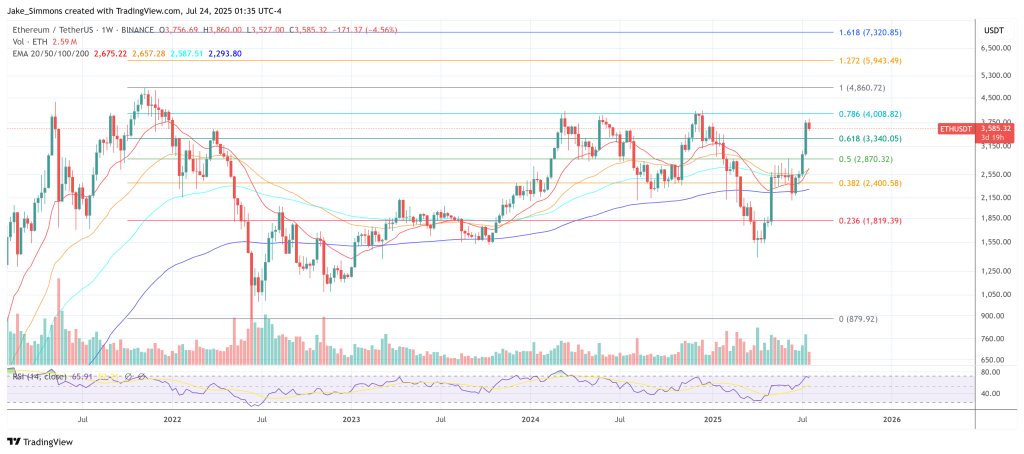A new research from analytics firm Artemis argues that Ether is undergoing the same reputational pivot Bitcoin experienced in the mid-2010s, but on fundamentally different terms. “Evaluating ETH purely through the lens of cash flows or protocol fees is a category error,” writes lead author Kevin Li. “It is better understood as a scarce yet productive, programmable reserve asset whose value accrues through its role in securing, settling and powering an increasingly institutionalized on-chain economy.”
Ethereum’s Path To Reserve Asset Status
Li begins by tackling the long-running critique that Ethereum’s flexible monetary policy disqualifies it as a store of value. He models a worst-case scenario in which every ETH in existence is staked and issuance hits its theoretical ceiling. Even then, annual inflation tops out at roughly 1.52 percent in 2025 and decays to 0.89 percent by 2125—well below the US dollar’s 6.36 percent average M2 expansion since 1998 and even beneath gold’s long-run annual supply growth. The paper argues that the combination of sublinear issuance and the EIP-1559 burn has already pushed net inflation near—or periodically below—zero, giving ETH a supply profile that “rivals gold while retaining the programmability of software.”
Macro conditions provide the backdrop for the thesis. Artemis notes that decades of monetary expansion have eroded trust in fiat and driven investors toward alternative stores of value. The US consumer-price index has averaged 2.53 percent a year since 1998, but the money supply has grown more than twice as fast, a gap the report claims “may account for a significant share of nominal equity-market gains.” Ethereum’s adaptive monetary policy, Li contends, offers a disciplined alternative without sacrificing the network’s ability to pay validators.
Institutional adoption is the second pillar of the argument. Over the past 12 months JPMorgan, BlackRock and Robinhood have each chosen Ethereum rails—either the base layer or an affiliated roll-up—for tokenized deposits, money-market funds and equity trading prototypes. The report cites BlackRock’s BUIDL fund and JPMorgan’s forthcoming JPMD deposit token as proof that blue-chip institutions are no longer experimenting on testnets but building products that will settle value at scale. “As traditional finance migrates on-chain, the need to hold and stake ETH becomes structural rather than discretionary,” Li writes.
That dynamic is visible in on-chain data. Artemis calculates that the supply of stablecoins and tokenized real-world assets on Ethereum reached a record $123 billion in June, while the amount of ETH locked in validators climbed to 35.5 million. The year-on-year correlation between the value of on-chain assets and staked ETH exceeds 88 percent across every major category the firm tracks, reinforcing the idea that demand for security and settlement drives demand for the native token.
Regulation, long the wild card for any staking-based value proposition, has started to tilt in Ethereum’s favor. On May 29 the US Securities and Exchange Commission’s Division of Corporation Finance issued guidance stating that protocol-level staking, delegated staking and certain custodial staking arrangements do not in themselves constitute securities offerings. While the ruling left room for fact-specific enforcement, it cleared the way for spot-ETH ETF filers to include staking provisions in their S-1 amendments. Several prospective issuers have since done exactly that, promising investors both passive exposure to ETH and a share of consensus rewards.
Competition For Bitcoin?
The Artemis report also highlights an emerging “treasury-asset wave” reminiscent of MicroStrategy’s Bitcoin strategy in 2020. Sharplink Gaming disclosed in late May that it would begin allocating corporate cash to Ether, a move followed by a cluster of smaller US and Asian public companies. Together they now hold more than 730,000 ETH, or roughly $2.6 billion at current prices. The accumulation has coincided with a period of ETH outperformance versus BTC—an unusual trend in the current cycle, which has otherwise been dominated by Bitcoin narratives such as halving supply shocks and prospective US reserve holdings.
Critics who argue that Layer 2 networks cannibalize Ethereum’s fee base “miss the point,” Li says. By off-loading execution while anchoring settlement and data availability to the base layer, roll-ups expand Ethereum’s total addressable market without eroding its security budget. Li compares the arrangement to the Federal Reserve System: “Regional banks handle day-to-day traffic, but ultimate settlement rests with the central bank.” In that analogy ETH is the reserve asset that guarantees finality.
The paper concedes that other high-throughput Layer 1s, particularly Solana, have siphoned off “meme-coin velocity” and micro-transaction volume. Solana processed more transactions than Ethereum in five of the past six quarters. Yet Li argues that the market for assets requiring maximal security is “orders of magnitude” larger than the market for speculative trading throughput, especially as traditional finance tokenizes bonds, deposits and money-market funds.
Perhaps the most pointed section of the report re-examines Bitcoin’s own “digital gold” narrative. Just as early critiques once dismissed BTC as volatile, illiquid and pointless, ETH today faces doubts about its identity. “Bitcoin users once had to justify why a purely digital bearer asset could compete with gold,” Li writes. “Ethereum users now have to justify why a programmable, yield-bearing, burn-limited asset can compete with bitcoin. The burden of proof is reversing.”
After Ethereum’s long-awaited transition to proof-of-stake and barely two months after the SEC’s staking guidance, the conversation around ETH has shifted from “utility token” to something far closer to “reserve asset.” If Li’s thesis holds, future debates may revolve less around whether Ethereum can catch Bitcoin’s market cap and more around what happens when institutions treat Ether not as gasoline for smart contracts but as the base money of the emerging on-chain economy.
At press time, ETH traded at $3,585.
